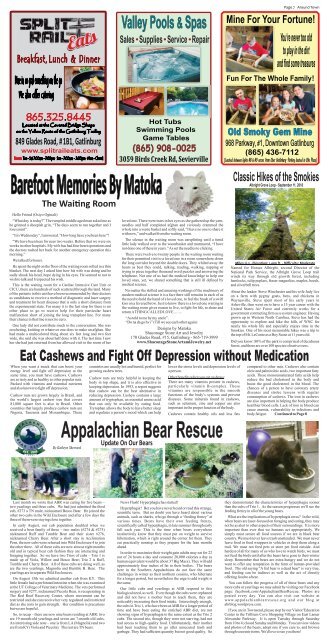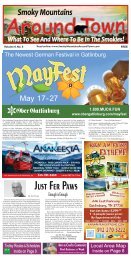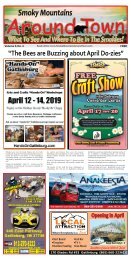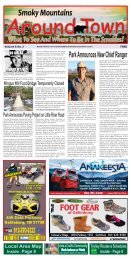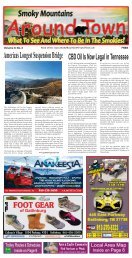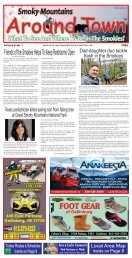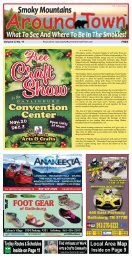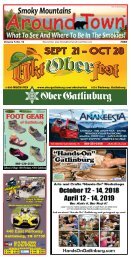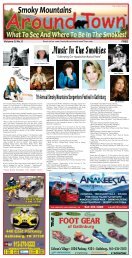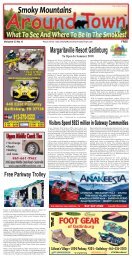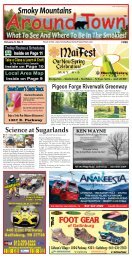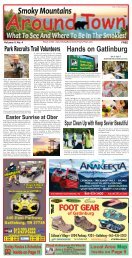Smoky Mountain Around Town / September 2018
What To See And Where To Be In The Smokies!
What To See And Where To Be In The Smokies!
Create successful ePaper yourself
Turn your PDF publications into a flip-book with our unique Google optimized e-Paper software.
Valley Pools & Spas<br />
Sales • Supplies • Service • Repair<br />
Page 7 <strong>Around</strong> <strong>Town</strong><br />
Mine For Your Fortune!<br />
You’re never too old<br />
to play in the dirt<br />
and find some treasures<br />
Fun For The Whole Family !<br />
849 Glades Road, # 1B1, Gatlinburg<br />
www.splitraileats.com<br />
Hot Tubs<br />
Swimming Pools<br />
Game Tables<br />
(865) 908-0025<br />
3059 Birds Creek Rd, Sevierville<br />
Old <strong>Smoky</strong> Gem Mine<br />
968 Parkway, #1, Downtown Gatlinburg<br />
(865) 436-7112<br />
(Located between lights #8 & #9 across from Ober Gatlinburg - Parking located in Elks Plaza)<br />
Classic Hikes of the Smokies<br />
Albright Grove Loop - <strong>September</strong> 11, <strong>2018</strong><br />
Hello Friend (Osiyo Oginali)<br />
“What day is today?” The rumpled middle aged man asked me as<br />
he grinned a sheepish grin, “The days seem to run together and I<br />
lose count”.<br />
“It is Wednesday”, I answered. “How long have you been here”?<br />
“We have been here for near two weeks. Before that we were six<br />
weeks in other hospitals. My wife has had four heart operations and<br />
the doctors rushed her back for another emergency operation this<br />
morning.”<br />
We talked for hours.<br />
The Wai ng Room<br />
He spent the night on the floor of the waiting room rolled in a thin<br />
blanket. The next day I asked him how his wife was doing and he<br />
sadly shook his head, hope dying in his eyes. He seemed to not to<br />
wish to talk and I respected his wish.<br />
This is the waiting room for a Cardiac Intensive Care Unit or<br />
CICU, there are hundreds of such scattered through the land. Many<br />
of the patients in this unit have been recommended by their doctors<br />
as candidates to receive a method of diagnostic and laser surgery<br />
and treatment for heart diseases that is only a short distance from<br />
the experimental state. For many it is the last stop for there is no<br />
other place to go to receive help for their particular heart<br />
malfunction short of joining the long transplant line. For many<br />
their chance in that line is next to zero.<br />
One lady did not contribute much to the conversation. She was<br />
crocheting, knitting or whatever one does to make an afghan. She<br />
had made a multicolored thing about six feet long and two feet<br />
wide, she said she was about half done with it. The last time I saw<br />
her she had just returned from her allowed visit to the room of her<br />
loved one. There were tears in her eyes as she gathered up the yarn,<br />
needles and half completed afghan and viciously crammed the<br />
whole into a waste basket and softly said, “I have no one to share it<br />
with now,” and walked from the waiting room.<br />
The silence in the waiting room was earsplitting until a timid<br />
little lady walked over to the wastebasket and murmured, “I have<br />
not done one of these in years.” As set the needles to clicking.<br />
There were twelve to twenty people in the waiting room waiting<br />
for their permitted visit to a loved one in a room somewhere down<br />
the long corridor beyond the double doors. They whiled away the<br />
hours as best they could, talking, reading, walking, napping or<br />
trying to piece together thousand word puzzles and answering the<br />
telephone. Not one of us had the medical knowledge to help our<br />
loved ones, yet, we shared something that is still ill defined by<br />
medical science.<br />
No matter the skilled and amazing workings of the machinery of<br />
modern medical science it is a fact there still remains in each of us<br />
the need to hold the hand of a loved one, to feel the brush of a swift<br />
kiss on a fevered brow. Just to know there is a loved one waiting in<br />
the waiting room gives reason to live, to fight for life, to share and<br />
return A THING CALLED LOVE…….<br />
“As told to me by my uncle”.<br />
“Do na da go hv i” (Till we see each other again)<br />
Designs by Matoka<br />
Shaconage Stone Art and Jewelry<br />
170 Glades Road, #15, Gatlinburg - 865-719-3999<br />
www.ShaconageStoneArtandJewelry.net<br />
Cashews contain healthy oils and less fats<br />
Appalachian Bear Rescue<br />
Miles: 6.5 - Elevation: 1,400 ft. - Difficulty: Moderate<br />
Named for Horace Albirght, second Director of the<br />
National Park Service, the Albright Grove Loop trail<br />
winds its way through old growth forest, including<br />
hemlocks, tulip poplars, fraser magnolias, maples, beech,<br />
and silverbell trees.<br />
About the leader: Steve Winchester and his wife Judy live<br />
on a farm with pygmy goats, bees, and chickens in<br />
Waynesville. Steve spent most of his early years in<br />
Asheville, then went on to have a 15 year career with the<br />
United States Air Force and currently works for a<br />
government contracting firm as a system engineer. Having<br />
grown up in Western North Carolina, Steve has had the<br />
opportunity to explore and hike the hills of WNC for<br />
nearly his whole life and especially enjoys time in the<br />
Smokies. One of his most memorable hikes was a trip to<br />
the top of Mt. LeConte as a Boy Scout at 11 years old.<br />
Did you know: 80% of the park is comprised of deciduous<br />
forest, and there are over 100 species of native trees.<br />
Eat Cashews and Fight Off Depression without Medication<br />
When you want a snack that can boost your<br />
energy level and fight off depression at the<br />
same time, you must have cashews. Cashews<br />
are as tasty and as healthy as other popular nuts.<br />
Packed with vitamins and essential nutrients<br />
and also known to fight off depression.<br />
Cashew nuts are grown largely in Brazil, and<br />
the world’s largest cashew tree that covers<br />
81,000 square feet is also in Brazil. Other<br />
countries that largely produce cashew nuts are<br />
Nigeria, Tanzania and Mozambique. These<br />
countries are usually hot and humid, perfect for<br />
growing cashew trees.<br />
Cashew nuts are truly helpful in keeping the<br />
body in top shape, and it is also effective in<br />
keeping depression. In 1993, a report suggests<br />
that cashew can be the best alternative in<br />
reducing depression. Cashew contains a large<br />
amount of tryptophan, an essential amino acid<br />
that can only be available by eating food.<br />
Trytophan allows the body to have better sleep<br />
and regulates a person’s mood which can help<br />
lower the stress levels and depression levels of<br />
a person.<br />
Other benefits when you eat cashews:<br />
There are many vitamins present in cashews,<br />
particularly vitamin B-complex. These<br />
vitamins are responsible in the smooth<br />
functions of the body’s systems and prevent<br />
diseases. Some minerals found in cashews,<br />
such as selenium, zinc and copper are also<br />
important in the proper function of the body.<br />
compared to other nuts. Cashews also contain<br />
oleic and palmitoleic acids, two important fatty<br />
acids. These monounsaturated fatty acids help<br />
reduce the bad cholesterol in the body and<br />
boost the good cholesterol in the blood. The<br />
chances of a person to have coronary artery<br />
diseases and stroke lessens with regular<br />
consumption of cashews. The iron in cashews<br />
are also important in helping the body produce<br />
healthier blood cells. Lack of iron in blood can<br />
cause anemia, vulnerability to infections and<br />
body fatigue. Continued to Page 8<br />
By Kathryn Sherrard<br />
Last month we wrote that ABR was caring for five bears –<br />
two yearlings and three cubs. We had just admitted the third<br />
cub, #273 a TN male, nicknamed Bosco Bear. He joined the<br />
other two cubs in the Wild Enclosure and after a few days the<br />
three of them were staying close together.<br />
In early August, our cub population doubled when we<br />
received a bear family of three – two males (#274 & #275)<br />
nicknamed Ruff and Tumble Bear and their sister #276,<br />
nicknamed Cherry Bear. After a short stay in Acclimation<br />
Pens, the new cubs were released into Wild Enclosure 4 to join<br />
the other three. All of these cubs are now almost eight months<br />
old and in typical bear cub fashion they are interacting and<br />
foraging together. So we have two Trios of cubs – Trio 1 is<br />
made up of Viola, Willow and Bosco Bear; Trio 2 is Ruff,<br />
Tumble and Cherry Bear. All of these cubs are doing well, as<br />
are the two yearlings, Magnolia and Bumble B. Bear. The<br />
yearlings are in separate Wild Enclosures.<br />
On August 15th we admitted another cub from KY. This<br />
little female had a perforated intestine when she was examined<br />
at the UT College of Veterinary Medicine. The vets performed<br />
surgery and #277, nicknamed Piccola Bear, is recuperating in<br />
The Red Roof Recovery Center, where movement can be<br />
restricted and she can receive her very regulated and restricted<br />
diet as she rests to gain strength. Her condition is precarious<br />
but we are hopeful.<br />
So, to recap – there are now nine bears residing at ABR: two<br />
are 19-month-old yearlings and seven are 7-month-old cubs.<br />
An interesting side note – one is from LA (Magnolia) and two<br />
are from KY (Viola and Piccola). The rest are TN bears.<br />
News Flash! Hyperphagia has started!<br />
Hyperphagia? Bet you have never heard or read this strange,<br />
scientific term. But no doubt you have heard about various<br />
animals, such as sharks, who go through a “feeding frenzy” at<br />
various times. Bears have their own feeding frenzy,<br />
scientifically called hyperphagia, in late summer through early<br />
fall each year. This is the time when bears everywhere<br />
instinctively know that they must put on weight to survive<br />
hibernation, which is right around the corner for them. They<br />
eat practically nonstop as they prepare for the lean months<br />
ahead.<br />
In order to maximize their weight gain adults may eat for 22<br />
out of 24 hours a day and consume 20,000 calories a day (a<br />
human equivalent would be about 37 Big Macs). They will add<br />
approximately four inches of fat to their bodies. The bears<br />
here in the Southern Appalachians do not face the same<br />
challenges in winter as their northern cousins, who hibernate<br />
for a longer period, but nevertheless the urge to add weight is<br />
the same.<br />
Our little cubs and yearlings at ABR respond to this<br />
biological need, as well. Even though the cubs were orphaned<br />
and did not have a mother bear to teach them, they are<br />
noticeably increasing their food intake. Interestingly enough,<br />
the cubs in Trio 1, who have been at ABR for a longer period of<br />
time and have been eating the enriched ABR diet, are not<br />
showing signs of hyperphagia to the same extent as the Trio 2<br />
cubs. The second trio, though they were not starving, had not<br />
had access to high-quality food. Unfortunately, their mother<br />
had been teaching them to go after unsecured trash and<br />
garbage. They had sufficient quantity but not good quality. So<br />
they demonstrated the characteristics of hyperphagia sooner<br />
than the cubs of Trio 1. As the season progresses we'll see the<br />
feeding frenzy in all of the young bears.<br />
What are the implications of hyperphagia on us? In the wild,<br />
when bears are laser-focused on foraging and eating, they may<br />
not be as alert to other aspects of their surroundings. It is more<br />
important than ever that we humans act appropriately. We<br />
simply must secure all food sources if we are in black bear<br />
country. We must never leave trash unattended. We must never<br />
leave food or food wrappers in vehicles or drop them along a<br />
trail. We must not feed pets or store pet food outside. And<br />
hardest of all for many of us who love to watch birds, we must<br />
not feed the birds until after the bears have gone to their winter<br />
sleep. Remember that bears are extra-hungry and we do not<br />
want to offer any temptation in the form of human-provided<br />
food. The old saying “A fed bear is a dead bear” is very true,<br />
and feeding can be indirect as well as the act of directly<br />
offering food to a bear.<br />
You can follow the progress of all of these bears and any<br />
more cubs or yearlings we may admit by visiting our Facebook<br />
page: facebook.com/AppalachianBearRescue. Photos are<br />
posted every day. You can also visit our website at<br />
www.appalachianbearrescue.org and our blog at<br />
abrblog.wordpress.com.<br />
If you are in <strong>Town</strong>send, please stop by our Visitor/Education<br />
Center in the Trillium Cove Shopping Village on East Lamar<br />
Alexander Parkway. It is open Tuesday through Saturday<br />
from 10 to 4; closed Sunday and Monday. You can view videos<br />
and photos of the bears, adopt one if you care to, and browse<br />
through souvenir items. We'd love to see you there!


